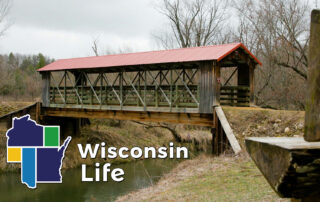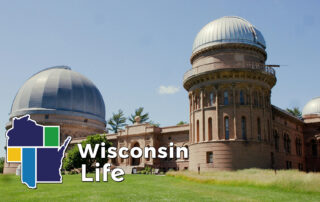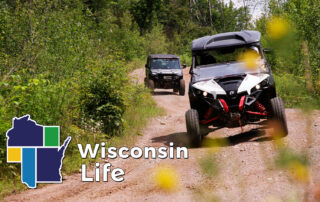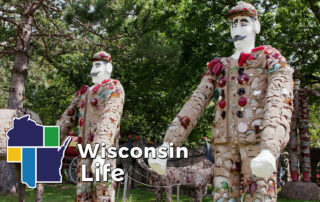Wisconsin Life host Angela Fitzgerald explores the Milwaukee Astronomical Society’s Observatory in New Berlin. This three-acre property is home to a group of amateur astronomers who maintain nine observatory buildings and telescopes. Members use the telescopes to take photographs of galaxies, nebulas – which are clouds of gas in space – planets and even the sun and moon. Fitzgerald speaks with observatory director Paul Borchardt about how this group got its start.
Audrey Hackbarth has a unique nickname: Alpaca Audrey. It started when Audrey was in a serious car accident and her husband bought her a baby alpaca to stay with her in the house. Audrey feel in love. She says, “She was so tiny, and so cute.” Smaller than a llama, alpacas are specifically bred for their fleece. Now with a herd of 50, Audrey and her alpacas are a familiar sight around Wisconsin Rapids. She explains, “I sit on the sidewalk and I’ll stand there and shear ’em. I’m mobbed with people, and they just watch me give ’em a haircut.” Audrey then makes all kind of items with the fleece including yarn, rugs and slippers.
Ruth Marty was a little girl when she first picked up her dad’s accordion. She explains, “He was the one that had a little schwyzerörgeli, which is a little button accordion.” Through the years, she took lessons and eventually taught others how to play the accordion. After marrying and having children, she didn’t play as much until she met a group of musicians from the Swiss enclave of Highland, Illinois. Ruth’s been playing with the group ever since. And in recent years, she’s found another bandmate: her granddaughter Sarah Marty. Sarah says, “It was the first instrument that I started to take lessons with grandma.” For the Marty clan, accordion is all in the family.
Aaron Bird Bear offers a tour of the UW-Madison that reveals a history that’s not so well known. The Assistant Dean for Student Diversity Programs in the School of Education guides his tour takers around campus. He explains, “These effigy mounds are only built in the western Great Lakes. You won’t find them anywhere else on planet Earth. That’s what makes UW-Madison such a special place.” Bird Bear points out the monuments to those that tried to vanquish that culture, language and way of life, starting with one of the most iconic landmarks on Bascom Hill: the statue of Abe Lincoln. In 1862, Bird Bear says, “He’s president during that; he is committed to the ethnic cleansing of the Ho-Chunk. He’s enacting our federal policy.” The tour takes a positive turn in a place called Dejope, a Ho-Chunk word meaning “four lakes.” Dejope Residence Hall is where the University of Wisconsin showcases Native American history.
Jessie Fritsch is an encaustic artist. She’s been painting with beeswax for 14 years. Considered one of the first forms of easel painting, dating back 2,000 years ago. Beeswax painting is a very durable form of painting since beeswax is a natural preservative. Fritsch was fascinated by the ancient history but says, “Once I actually used the medium and saw how vibrant the colors were, I was completely hooked.” With encaustic painting, time is of the essence. While there is no drying time, she has about five to eight seconds to put the paint down before it begins to clump up and won’t flow off her brush anymore. “Luckily wax is very forgiving,” she explains. “If you put it down and you didn’t like it, you can just scrape it off and start over.”



